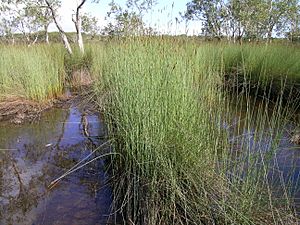Bare twig-rush facts for kids
Quick facts for kids Bare twig-rush |
|
|---|---|
 |
|
| Scientific classification | |
| Genus: |
Machaerina
|
| Species: |
juncea
|
| Synonyms | |
|
|
The Bare twig-rush (scientific name: Machaerina juncea) is a type of plant called a sedge. It's part of the Cyperaceae family, which includes many grass-like plants. You can find this plant growing naturally in Australia, New Zealand, and New Caledonia. It's also known as the tussock swamp twig rush.
What Does It Look Like?
The Bare twig-rush looks a lot like grass. It's a perennial plant, meaning it lives for more than two years. It grows from underground stems called rhizomes. These rhizomes help the plant spread easily.
This sedge usually grows to be about 0.2 to 1.2 meters (0.7 to 3.9 feet) tall. Its woody rhizomes are about 3 to 10 millimeters (0.1 to 0.4 inches) thick. They are covered with light brown, papery layers.
The plant has stiff, upright stems called culms. These culms are smooth and have a slightly bluish-green color. They grow in crowded clumps from the rhizomes. The leaves are mostly light brown or reddish layers that wrap around the stem.
Flowers and Seeds
The Bare twig-rush blooms between October and March. It produces brown flowers. The flowers grow on a stiff, upright stalk called an inflorescence. This stalk looks like a spike and is about 25 to 100 millimeters (1 to 4 inches) long.
Small, reddish-brown flower clusters, called spikelets, grow on this stalk. Each spikelet is about 4 to 5 millimeters (0.16 to 0.20 inches) long. They usually contain one or two tiny flowers. After flowering, the plant forms a small, oval-shaped seed, called a nut. This nut is about 2.5 to 3 millimeters (0.10 to 0.12 inches) long. It is dark brown to black, with an orange color near its base.
How Scientists Name It
The Bare twig-rush was officially described by a botanist named Tetsuo Koyama in 1956. He wrote about it in a scientific paper called Taxonomic Study of Cyperaceae.
Like many plants, the Bare twig-rush has had several different scientific names over time. These older names are called synonyms. Some of its past names include Baumea juncea and Cladium junceum.
Where Does It Grow?
This plant is found in many places. In New Zealand, it's common on the North Island. You can also find it, though less often, on the South Island. It likes to grow in wet areas like swamps, salt marshes, and along the edges of lakes and rivers.
In Australia, the Bare twig-rush grows along the coast in all states. In Western Australia, it's found in coastal areas of regions like the Mid West and South West. It prefers sandy soils that are often water-logged.

